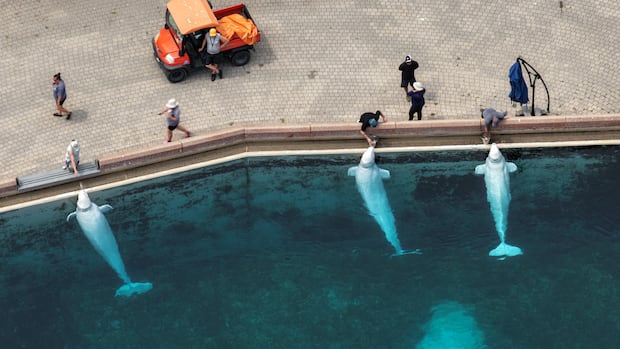As It Happens6:31Why chimpanzees are sticking grass and sticks in their butts
A group of chimpanzees in Zambia have resurrected an old fashion trend with a surprising new twist.
Fifteen years after a female chimpanzee named Julie first stuck a blade of grass into her ear and started a hot new craze among her cohort at the Chimfunshi Wildlife Orphanage, an entirely new group of chimps at the refuge have started doing the same thing.
“We were really shocked that this had happened again,” Jake Brooker, a psychologist and great apes researcher at Durham University in England, told As It Happens host Nil Kӧksal.
“We were even more shocked that they were doing their own spin on this by also inserting the grass and sticks in a different orifice.”
The chimps, he says, have been putting blades of grass and sticks into their ears and anuses, and simply letting them dangle there for no apparent reason.
The study, published in the journal Behaviour last week, sheds new light on how social-cultural trends spread and change among our primate cousins, much like they do among humans.
They learned it from us. Some of it, anyway
In fact, the researchers suspect the chimps learned the behaviour from people — the ear part, that is.
The two groups of chimps who display the behaviour don’t have any contact with each other. But they do share some of the same human caretakers.
And those caretakers, the study notes, reported that they sometimes use match sticks or blades of grass to clean their ears when working at the animal sanctuary.
The chimps, Brooker says, “have potentially copied it from a human who was walking by the enclosure, or one of the caregivers who was just going about their daily lives.”
“Like with all cultures, things change over time and they get refined and new quirks and new traditions pop up,” he said.
Chimpanzee influencers
In this case, the team traced the “new quirk” to a male chimp named Juma, who seems to have originated the grass-in-butt variation.
From there, the study shows, it spread rapidly to most of his groupmates within a week.
The same thing happened to Julie’s group. She started putting grass in her ear in 2010, and pretty soon, seven other chimps were doing the same.
The phenomenon even continued after Julie died in 2013. The researchers observed Julie’s group again for this new study, and found that two chimps, including Julie’s son, were still wearing grass in their ears.

Much like humans, Brooker says the chimps appear to be willing to suffer for the sake of fashion.
“You see when they’re learning this behaviour that it’s quite uncomfortable,” he said of the ear grass. “They shake their head and they rub the ear a little bit as if they’re trying to get used to it.”
Once they adjust, he says, they appear largely unbothered. He likened it to people getting their ears pierced.
“There’s not a clear benefit that wearing earrings really brings, but some kind of social cultural reason,” he said. “I feel like it’s similar with the grass in the ear.”
It’s an apt comparison, says Julie Teichroeb, a primatologist at the University of Toronto who wasn’t involved in the study.
“It just looks like an earring, you know, like a fashionable way to present yourself,” she said.
‘They spend a lot of time looking at each other’s butts’
And as for Juma’s grass-in-butt variation?
Teichroeb says it’s possible they’re doing it to make themselves more attractive to potential mates. Females, in particular, she noted, display a swelling on their rear ends to indicate when they’re receptive to a little hanky panky.
“They spend a lot of time looking at each other’s butts,” she said. “So it’s kind of not surprising maybe that they were innovating this way to sort of decorate their butts.”
Cultural differences are common among primates, and other animals too, but they often boil down to different methods of accessing food and other resources.
Because the Chimfunshi chimps have human caretakers who feed them, Teichroeb says they may have more free time to develop purely social trends.
“We think of, like silly, little pointless cultural ideas that spread amongst people,” she said.
“Learning that animals have these kinds of same, pointless little behaviours that become fads and become viral, I think it really shows how closely related we are to them, how much kinship we actually share.”
Brooker says it reminds him of the orcas who have recently been spotted wearing salmon on their heads like a hat — a behaviour last reported in the ’70s.
“It re-emerged 40 years later, like flared jeans,” Brooker said.
In that case, scientists also theorize the trend could be related to an abundance of food after many years of scarcity.
Weird as this study was, Brooker says it’s only the second most surprising behaviour he’s observed in chimpanzees.
The most surprising, he says, was when he happened upon two male chimps engaging in “post-conflict fellatio.”
“The chimpanzees always give me something new to pique my interest,” he said.







